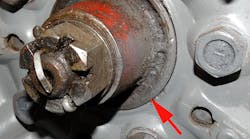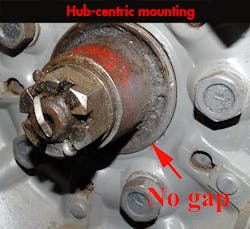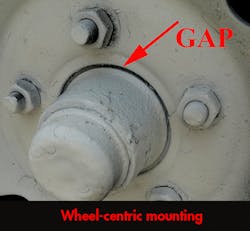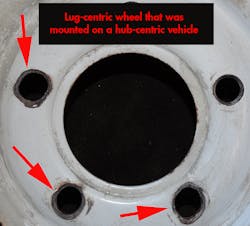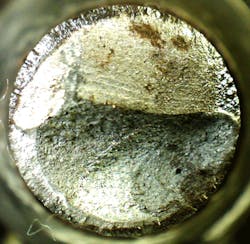What’s the Difference Between Lug-centric and Hub-centric Wheels?
There are two commonly used ways to fasten wheels to a hub: lug-centric and hub-centric. In hub-centric designs (see figure below), the wheel fits snugly against the hub which provides support along with the wheel lugs.
In lug-centric mountings, the wheel lugs center and support the wheel with no support from the hub because of the gap (as indicated by the arrow). (See figures below.)
The easiest way to tell the difference between the two designs is to look at the hub of a hub and wheel assembly. If the hole in the center of the wheel fits snugly against the hub, then it is hub-centric. If there is a gap between the center hole of the wheel and the hub, then it is lug-centric.
Automotive applications usually use the hub centric design because the support and centering of the wheel better resists impact loads from being used on typical roads. Other low-speed and low-impact applications use lug-centric designs which are less costly and strong enough for these applications. Golf carts, for example, often use lug-centric designs.
Aftermarket wheel manufacturers typically sell lug-centric attachments because the wheels will work on a wider variety of vehicles without having a specific wheel shape for a hub. Some aftermarket manufacturers provide a spacer that goes in the gap to mimic a hub-centric design. The spacer looks like a large washer that fits in the gap between the hub and wheel. It is designed to contact both the wheel and hub and acts as a means of transferring lug loads to the hub.
A problem arises when using a lug-centric wheel on a vehicle and suspension that was originally a hub-centric design. Without the hub’s support, road impacts can deform lugs enough to where the wheel is no longer concentric with the hub, leading to vibrations. This can reduce the clamping force of the wheel to the hub. Road loading conditions can then move the wheel around on the hub, as can be seen by the worn holes in the image below of a lug-centric wheel used on a hub-centric vehicle.
In this instance, the lugs could not adequately clamp and center the wheel to the hub. The run-out (off-centered operation) created enough vibrations that the lugs suffered fatigue failure, the wheel came off the vehicle, and there was an accident.
In another mismatch in which a lug-centric wheel was installed on a hub requiring a hub-centric wheel, the loss of clamping force led to a fatigue failure of the bolt (see cross-section of failed bolt below).
It should be noted that hub-centric and lug-centric wheels are distinct designs with different stress levels at different locations. Substituting a lug-centric wheel in place of a hub-centric wheel can decrease reliability, especially in high wheel-loading and impact- loading environments.
Charles C. Roberts, Jr., Ph.D., P.E., is an engineering consultant in the areas of accident reconstruction, failure analysis, structural analysis, heat transfer, fire origin analysis, computer analysis, mechanics, and biomechanics.
Looking for parts? Go to SourceESB.
